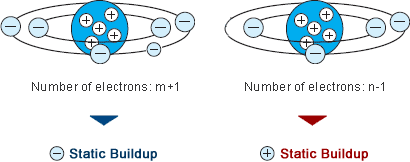|
|
Static electricity occurs with the movement of an electric charge caused by contact or friction between two objects.

1. The atom consists of positively charged protons, negatively charged electrons, and neutrons. Typically the number of protons and electrons is the same. This maintains an electrically neutral and stable condition.

2. However, when two objects make contact or when friction occurs between them, An electron is transferred from an atom of one material to an atom of another material. When this occurs, electrons move from the material with a weaker bond to the material with a stronger bond.

3. With this movement of electrons, the materials lose their electrical neutrality, and static electricity is accumulated. The material that attracted the electron is negatively charged and the material from which the electron was lost is positively charged. This is the Mechanism for the Generation of Static Electricity.
1-888-KEYENCE
(1-888-539-3623)